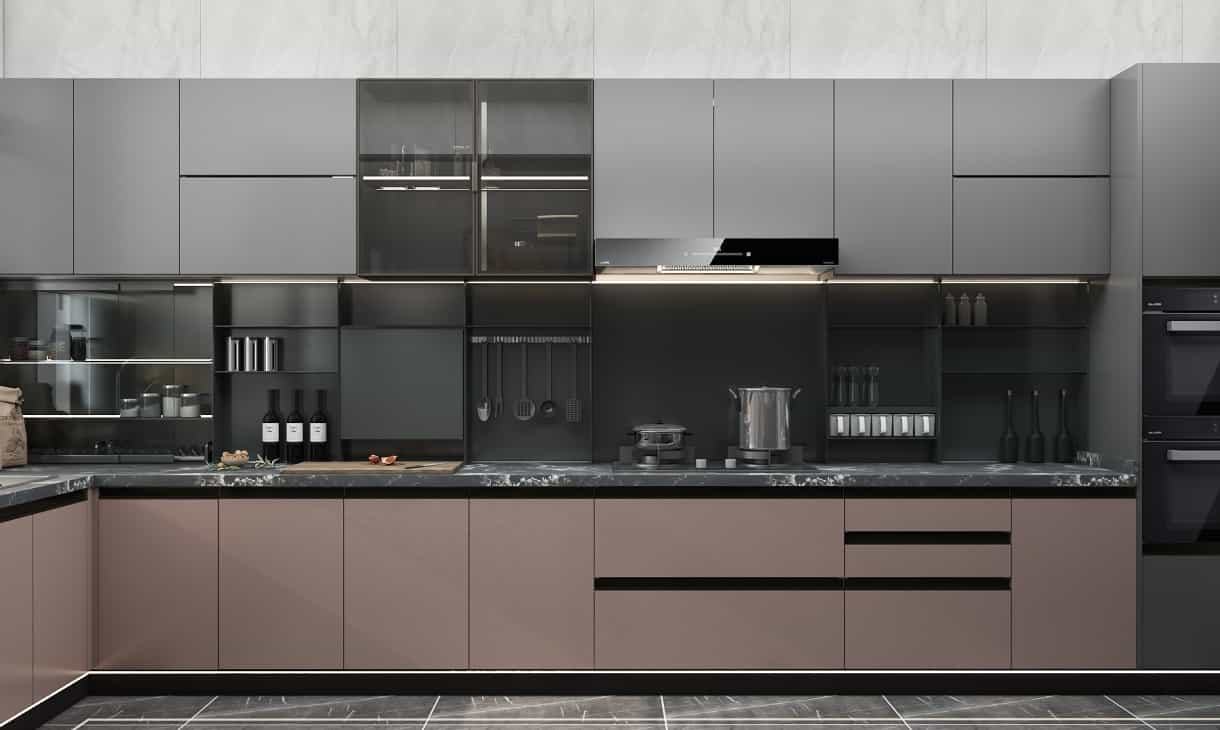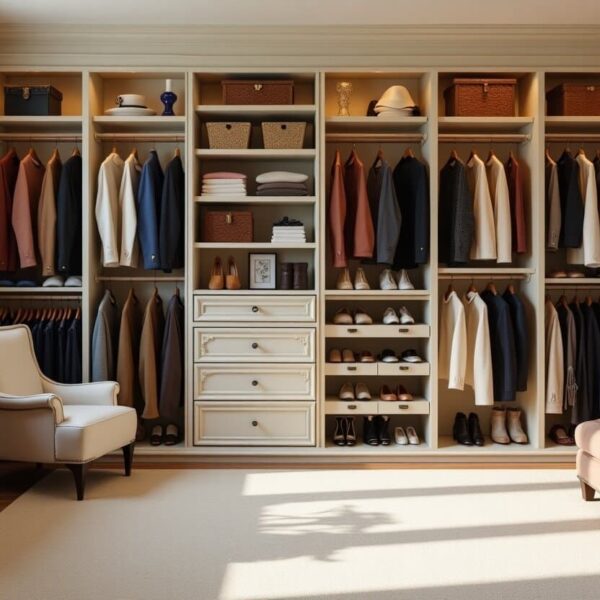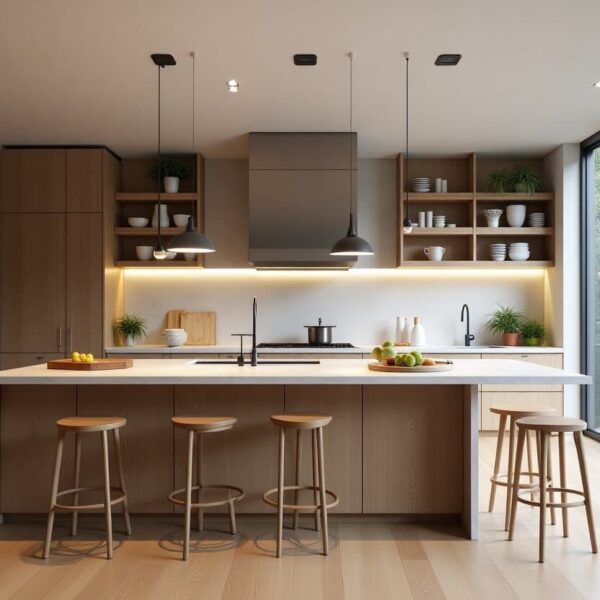When embarking on the journey of choosing a custom wardrobe from China, most people understandably fixate on material quality and internal layouts. Yet, a crucial decision often gets overlooked: the wardrobe door design. Far from being a mere opening and closing mechanism, the wardrobe door is where practical functionality and spatial aesthetics converge.
For those with limited space or a desire for unique, high-quality solutions, sourcing custom wardrobes from China can unlock an incredible realm of personalized possibilities. This article will delve into the core characteristics of three popular wardrobe door types—sliding, hinged, and folding—from both a design logic and practical value perspective. Our goal is to help you find the perfect “design language” for your unique space.
Sliding Doors
Sliding doors, with their horizontal-gliding operation along a track, eliminate the need for any outward swing, making them an excellent choice for saving floor space. Unlike traditional hinged doors that demand specific clearance for opening, sliding doors seamlessly integrate into narrow bedrooms, hallways, or compact walk-in closets, ensuring every inch of space is efficiently utilized.
This door type isn’t just a practical solution for space optimization; it also embodies a minimalist design aesthetic. Frameless panels paired with hidden handles create clean, crisp vertical lines. Their simple, pure visual language perfectly complements contemporary interior styles such as Nordic minimalist, Japanese Zen, and urban modern.
In terms of space planning, sliding doors are particularly friendly to small households: calculating the layout is straightforward, requiring only the combined dimensions of the door panel width and track thickness. They also offer significant safety advantages—the absence of outward-swinging panels greatly reduces the risk of pinched fingers, making them especially suitable for homes with children. Furthermore, large door panels support a wide array of customization options. Materials and finishes like mirrors, frosted glass, wood grain laminates, and even artistic prints can transform the wardrobe from a mere storage unit into a visual highlight within the space.
Of course, sliding doors do have their limitations. Only a portion of the wardrobe can be accessed at one time, preventing a complete view of the interior. Tracks are prone to accumulating dust and debris, requiring regular cleaning, and rollers may need replacement as they wear over time. During installation, it’s also crucial to ensure that the wall or door opening is wide enough to accommodate the sliding mechanism. For professional advice, pay close attention to the track material—tests show a significant difference in wear between aluminum and stainless steel tracks after 300,000 cycles, with high-quality aluminum tracks demonstrating superior durability in most scenarios.
Overall, sliding doors are undoubtedly an ideal choice for households with limited space and a preference for a minimalist lifestyle.

Hinged Doors
Hinged doors are the most traditional and widely used type of wardrobe door. They operate in the simplest, most direct way: each door swings outward on hinges. While this design is ancient, it’s incredibly intuitive and practical—open the door panel, and the entire wardrobe interior is immediately visible. For users who prioritize storage clarity and want to quickly find what they need, hinged doors offer unparalleled convenience.
Another advantage of hinged doors lies in their potential for interior expansion. You can easily install mirrors, hooks, or even small storage compartments on the back of the door, creating a versatile three-in-one functionality for makeup, dressing, and storage. This makes hinged doors especially suitable for families looking to enhance practicality within limited spaces.
In terms of appearance, hinged doors offer more stylistic freedom than other door types. Whether it’s French carved door panels, American pastoral styles, minimalist modern, New Chinese, or even vintage eclectic, hinged doors can easily match. Simultaneously, the choice of door handles is extremely diverse, and their rich customization potential allows them to seamlessly and beautifully integrate with a wide range of styles, from traditional and European to American, New Chinese, or even vintage aesthetics.
However, hinged doors have relatively higher space requirements. Since the door panels need to swing outward, sufficient clearance must be reserved. Therefore, they are not suitable for narrow bedrooms or areas with dense furniture. Ergonomically, it’s recommended that the opening area’s width be at least 1.25 times your shoulder width to ensure smooth and unrestricted movement during use.
Furthermore, for wardrobes with larger door panels or heavier materials, the quality of the hardware is crucial. Inferior hinges can lead to door sagging and misalignment, affecting both aesthetics and lifespan. Thus, when choosing hinged doors, it’s advisable to pair them with durable, high-quality hardware to ensure long-term stability.
Despite these limitations, hinged doors remain widely popular due to their practicality and classic appearance. They not only provide a complete view of the wardrobe’s interior but also support additional functional installations and adapt to various decor styles. For families seeking comprehensive functionality and versatile styling, hinged doors remain a trustworthy and excellent choice.

Folding Doors
Folding doors, constructed from two or more panels connected by hinges, open by neatly folding and stacking along a track, creating a distinctive opening style. This design cleverly bypasses the significant outward swing space required by hinged doors while overcoming the limitation of sliding doors that only allow partial access. It simultaneously saves floor space and offers an almost complete view of the wardrobe’s interior.
This door type is particularly practical for small households. In cramped bedrooms, shared closet areas, or multi-functional rooms, the panels can compactly retract to one or both sides, avoiding excessive occupation of wall and passageway space, making living scenarios more flexible and efficient. Its full-opening passage advantage is especially prominent when multiple people need to access items simultaneously or quickly find clothes.
Aesthetically, folding doors infuse a modern design sensibility into the home, perfectly aligning with contemporary minimalist, neutral-toned, and minimalist styles. They also offer excellent functional flexibility—you can partially or fully open them as needed to easily adjust airflow and light within the space. High-quality folding doors prioritize the living experience, not only enabling silent operation but also providing good sound insulation, adding a comfortable quality to daily life.
However, choosing folding doors also requires considering their limitations: the initial cost is typically higher than that of sliding doors and hinged doors, and the installation process is more complex. Tracks are prone to accumulating dust and require regular cleaning; if large glass panels are used, cleaning frequency will be higher. In terms of safety, they rely on multi-point locking mechanisms and tempered glass, with quality being especially crucial in larger installations. Furthermore, the multiple frame lines formed when the panels are folded might be a slight drawback for users seeking an extremely seamless view.
Overall, if you value the convenience of full-access retrieval, functional versatility, and contemporary design aesthetics, folding wardrobe doors are undoubtedly a smart choice that combines both design appeal and practicality.
Have a project in mind? Send a message.
Get the catalog for free
Matching Your Door to Your Home's Architectural Style
Your wardrobe door isn’t just a functional component; it’s an integral part of your home’s architectural style and overall coherence. The type of door you choose should align seamlessly with your interior aesthetic, avoiding elements that clash with the existing visual system.
For American Traditional homes, paneled hinged doors are a common and fitting choice. Their clear structural lines and classic design meet the style’s conventional demands for decorative detail and symmetry. In contrast, folding doors with a frameless, modern, and sleek appearance are generally unsuitable in this style of environment.
In spaces leaning towards Bauhaus Minimalist, the design emphasizes clean lines and visual restraint. Sliding doors with concealed tracks are well-suited here. Their integrated tracks and minimalist look help maintain the overall minimalist logic of space. Ornate or decorative glass doors, however, would easily disrupt this sense of simplicity and should be avoided.
Mediterranean Revival homes prioritize natural textures and surfaces. Distressed wooden folding doors can create excellent unity within this environment. The wood’s inherent grain and finishing techniques harmonize with earthy tones, arched walls, and handcrafted wall textures. Conversely, industrial-style doors with metallic structures would likely create a stylistic conflict in such spaces.
Some design approaches do allow for the combination of different stylistic elements. For example, in Conflicting Aesthetics, a Colonial-style hinged door might be juxtaposed with a space-aluminum folding door, forming a visually contrasting structure. In Deconstructionism, fragmented sliding doors arranged in an unconventional layout can break traditional compositions, creating an unconventional spatial arrangement.
Regardless of the stylistic direction, the choice of wardrobe doors should extend beyond just the opening mechanism or singular decorative appeal. It needs to be considered from the perspective of overall architectural and interior design consistency, ensuring space integrity and clear logic.

Climate Adaptation Report
| Environment | Material | Expansion Rate | Conclusion |
|---|---|---|---|
| Humid (90%) | Solid wood hinged | 0.83% | High crack risk ✘ |
| Humid (90%) | WPC sliding | 0.18% | Acceptable ✓ |
| Humid (90%) | Aluminum-glass fold | 0.05% | No change ✓ |
| Cold (-20°C) | WPC sliding | -12% elasticity | Moderate risk |
| Cold (-20°C) | Aluminum-glass fold | No change | Safe ✓ |
These insights are crucial for longevity and performance, particularly if you live in a region with extreme weather conditions.
The Wardrobe Door Selection Guide
When choosing your wardrobe door, you’ll need to consider your room size, decor style, budget, typical storage habits, household size, and even the local weather.
First, take a look at your bedroom’s size. If space is tight, sliding doors or folding doors are often more practical, saving significant floor space. For larger rooms, you’ll have more options, but still think about how the doors open and if they’ll impact traffic flow or furniture placement.
Next, consider your preferred style. Do you lean towards a traditional aesthetic? Then hinged doors with their classic appeal might be just right for you. If you prefer a more modern feel, sliding or folding doors usually deliver that sleek, contemporary look.
Budget is also a big factor. If you’re looking for something more economical, hinged doors or standard sliding doors often offer great value. But if you’re aiming for high-end custom solutions, folding doors or mirrored sliding doors can provide that refined, sophisticated touch.
How you typically organize your belongings matters too: do you want to see all your clothes at a glance for easy outfit planning? If so, hinged doors or folding doors give you a clear view of everything inside. If you’re okay with accessing sections at a time and don’t mind opening only a portion, then sliding doors will work just fine.
Your household situation is also relevant. If multiple people share a wardrobe, folding doors can be quite convenient, allowing simultaneous access without getting in each other’s way. For homes with seniors or children, the safer operation of sliding doors, which don’t swing outwards, can prevent bumps and scrapes.
Finally, don’t overlook your local climate. In humid or tropical regions, choosing WPC (Wood Plastic Composite) or aluminum-framed doors offers better moisture and warp resistance. Conversely, in dry or cold areas, it’s generally best to avoid solid wood materials that are prone to cracking or significant deformation.
Each door type has its own strengths. The right choice depends on your actual needs, space limitations, and lifestyle. When in doubt, consult a professional wardrobe manufacturer who can provide guidance based on experience and offer mixed-use configurations. This ensures that your wardrobe solution fits your home both functionally and visually.

No Best, Only Best Fit.
Hinged, sliding, and folding doors each have their strengths and weaknesses. There’s no absolute “better” option, only the one that best suits your specific needs and preferences.
We highly recommend consulting a professional Chinese custom wardrobe maker. They can accurately match your space with your requirements and even combine two or more door types to create a truly unique home experience. If you’re still weighing your options, consider reaching out to a professional custom brand like Nexthome Furnishing. With over a decade of expertise in high-end customization, we specialize in providing wardrobe door solutions that meet the practical needs of international households. From design drawings and material selection to production, delivery, and after-sales service, we offer truly bespoke solutions that will elevate your living space.
Contact NextHome Now!
We are here to help you with your business needs. We have a team of experts who are always eager to help you.



